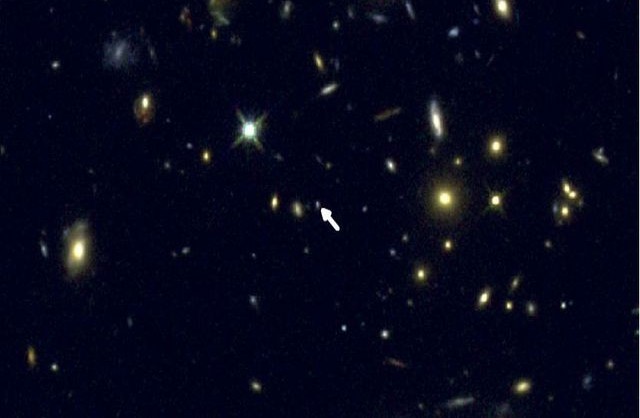UCLA astronomers have made the first accurate measurement of the abundance of oxygen in a distant galaxy. Oxygen, the third-most abundant chemical element in the universe, is created inside stars and released into interstellar gas when stars die. Quantifying the amount of oxygen is key to understanding how matter cycles in and out of galaxies.
This research is published online in the Astrophysical Journal Letters, and is based on data collected at the W. M. Keck Observatory on Mauna Kea, in Hawaii.
“This is by far the most distant galaxy for which the oxygen abundance has actually been measured,” said Alice Shapley, a UCLA professor of astronomy, and co-author of the study. “We’re looking back in time at this galaxy as it appeared 12 billion years ago.”
Knowing the abundance of oxygen in the galaxy called COSMOS-1908 is an important stepping stone toward allowing astronomers to better understand the population of faint, distant galaxies observed when the universe was only a few billion years old and galaxy evolution, Shapley said. COSMOS-1908, contains approximately 1 billion stars. In contrast, the Milky Way contains approximately 100 billion stars; some galaxies in the universe contain many more, while others contain many fewer. Furthermore, COSMOS-1908 contains approximately only 20 percent the abundance of oxygen that is observed in the sun.
Typically, astronomers rely on extremely indirect and imprecise techniques for estimating oxygen abundance for the vast majority of distant galaxies. But in this case, UCLA researchers used a direct measurement, said Ryan Sanders, astronomy graduate student and the study’s lead author. The researchers used an extremely advanced and sophisticated instrument called MOSFIRE (Multi-Object Spectrometer for Infra-Red Exploration) installed on the Keck I telescope at the Keck Observatory. This five-ton instrument was designed to study the most distant, faintest galaxies, said UCLA physics and astronomy professor Ian McLean, project leader on MOSFIRE and director of UCLA’s Infrared Laboratory for Astrophysics. McLean built the instrument with colleagues from UCLA, the California Institute of Technology and UC Santa Cruz and industrial sub-contractors.
Source: newsroom.ucla.edu
































